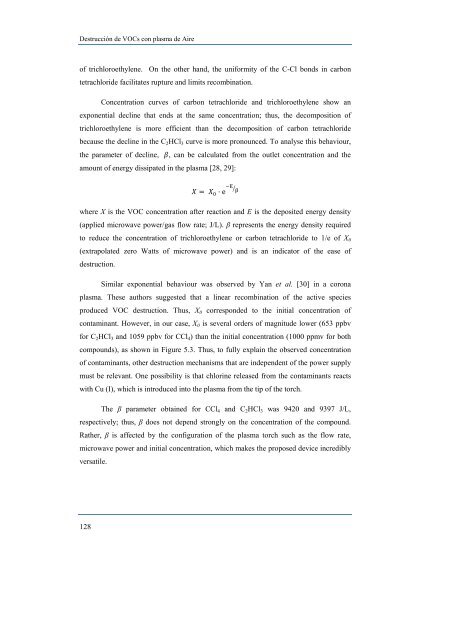estudio y caracterización de un plasma de microondas a presión ...
estudio y caracterización de un plasma de microondas a presión ...
estudio y caracterización de un plasma de microondas a presión ...
You also want an ePaper? Increase the reach of your titles
YUMPU automatically turns print PDFs into web optimized ePapers that Google loves.
Destrucción <strong>de</strong> VOCs con <strong>plasma</strong> <strong>de</strong> Aire<br />
of trichloroethylene. On the other hand, the <strong>un</strong>iformity of the C-Cl bonds in carbon<br />
tetrachlori<strong>de</strong> facilitates rupture and limits recombination.<br />
128<br />
Concentration curves of carbon tetrachlori<strong>de</strong> and trichloroethylene show an<br />
exponential <strong>de</strong>cline that ends at the same concentration; thus, the <strong>de</strong>composition of<br />
trichloroethylene is more efficient than the <strong>de</strong>composition of carbon tetrachlori<strong>de</strong><br />
because the <strong>de</strong>cline in the C2HCl3 curve is more prono<strong>un</strong>ced. To analyse this behaviour,<br />
the parameter of <strong>de</strong>cline, , can be calculated from the outlet concentration and the<br />
amo<strong>un</strong>t of energy dissipated in the <strong>plasma</strong> [28, 29]:<br />
<br />
where X is the VOC concentration after reaction and E is the <strong>de</strong>posited energy <strong>de</strong>nsity<br />
(applied microwave power/gas flow rate; J/L). β represents the energy <strong>de</strong>nsity required<br />
to reduce the concentration of trichloroethylene or carbon tetrachlori<strong>de</strong> to 1/e of X0<br />
(extrapolated zero Watts of microwave power) and is an indicator of the ease of<br />
<strong>de</strong>struction.<br />
Similar exponential behaviour was observed by Yan et al. [30] in a corona<br />
<strong>plasma</strong>. These authors suggested that a linear recombination of the active species<br />
produced VOC <strong>de</strong>struction. Thus, X0 correspon<strong>de</strong>d to the initial concentration of<br />
contaminant. However, in our case, X0 is several or<strong>de</strong>rs of magnitu<strong>de</strong> lower (653 ppbv<br />
for C2HCl3 and 1059 ppbv for CCl4) than the initial concentration (1000 ppmv for both<br />
compo<strong>un</strong>ds), as shown in Figure 5.3. Thus, to fully explain the observed concentration<br />
of contaminants, other <strong>de</strong>struction mechanisms that are in<strong>de</strong>pen<strong>de</strong>nt of the power supply<br />
must be relevant. One possibility is that chlorine released from the contaminants reacts<br />
with Cu (I), which is introduced into the <strong>plasma</strong> from the tip of the torch.<br />
The β parameter obtained for CCl4 and C2HCl3 was 9420 and 9397 J/L,<br />
respectively; thus, β does not <strong>de</strong>pend strongly on the concentration of the compo<strong>un</strong>d.<br />
Rather, β is affected by the configuration of the <strong>plasma</strong> torch such as the flow rate,<br />
microwave power and initial concentration, which makes the proposed <strong>de</strong>vice incredibly<br />
versatile.

















